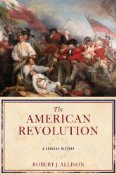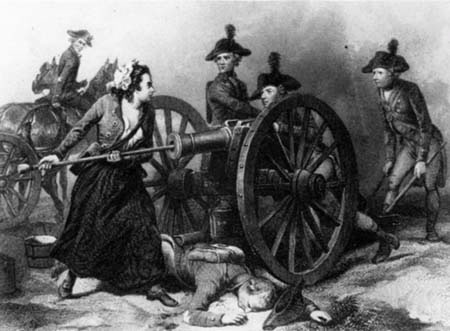
The American Revolution A Concise History by Robert J. Allison
 This small hardback is somewhat deceptive due to its diminutive size and its title. While barely 100 pages in length, the font is pretty small and author Robert Allison manages to pack in quite a lot of information and even some aptly chosen pictures. Like recent books by Harlow Giles Unger, Allison has carefully chosen very interesting and appropriate pictures for his Concise History. These are just enough to break up the text, and like Unger’s books share the page with text (rather than in the typical glossy picture page sections). Unlike Unger’s books, most if not all of Allison’s selections come courtesy of the Massachusetts Historical Society.
This small hardback is somewhat deceptive due to its diminutive size and its title. While barely 100 pages in length, the font is pretty small and author Robert Allison manages to pack in quite a lot of information and even some aptly chosen pictures. Like recent books by Harlow Giles Unger, Allison has carefully chosen very interesting and appropriate pictures for his Concise History. These are just enough to break up the text, and like Unger’s books share the page with text (rather than in the typical glossy picture page sections). Unlike Unger’s books, most if not all of Allison’s selections come courtesy of the Massachusetts Historical Society.
Besides interesting and well-chosen pictures and illustrations, Allison has done a good job capturing the high points of the country’s beginning. He starts with the Albany Conference of 1754 and concludes with the death of Thomas Jefferson and John Adams on the 50th anniversary of the Declaration of Independence on July 4, 1826.
Allison is necessarily brief and glosses over much and omits some things entirely. Nevertheless the writing is succinct and crisp and some of his choices about what to highlight are interesting. He devotes almost 20% of the short book to The Sons of Liberty, Tea Party Patriots, Boston, and the state of affairs that the colonies were in prior to the revolution.  There are a lot of interesting facts in his narrative which are not elaborated any more than is minimally required for the reader to understand whatever point the author is making.  But these facts nonetheless provide interesting color for the student of history. For example, in discussing the fractiousness of the colonies he gives background on something that Hamilton referred to in Federalist No. 7, the dispute between Pennsylvania and Connecticut over the Wyoming Valley:
Massachusetts and New York had a long-standing dispute over the land between the Connecticut and Hudson rivers, and New York was on the verge of war with New Hampshire over Vermont, with the people of the area adamantly against being part of either. Pennsylvania and Connecticut both claimed the Wyoming Valley, which Connecticut settlers were farming under their 17th century charter.
In Federalist No. 7, Hamilton makes the point that left to their own devices the colonies would resume the fractious behavior that existed prior to the Revolution.
In the wide field of Western territory, therefore, we perceive an ample theatre for hostile pretensions, without any umpire or common judge to interpose between the contending parties. To reason from the past to the future, we shall have good ground to apprehend, that the sword would sometimes be appealed to as the arbiter of their differences. The circumstances of the dispute between Connecticut and Pennsylvania, respecting the land at Wyoming, admonish us not to be sanguine in expecting an easy accommodation of such differences.
Allison also includes several interesting anecdotes, at least one of which has special relevance for today.
Pain recalled a tavern keeper in Amboy who stood at his door talking politics, with his small child by his side. The father concluded his political discourse, “Well! Give me peace in my day.” Paine was outraged. The man was hardly a father at all — “a generous parent should have said, “If there must be trouble, let it be in my day, that my child may have peace.”

Massachusetts Historical Society
There are also 2 brief vignettes about notable women in the Revolution. The first concerned “Molly Pitcher”, the wife of gunner William Hays. She got her nickname because she carried water to cool both the men and the guns. When her husband was wounded, she took his place at the gun. She followed her husband and the army through Valley Forge and would later receive a pension and a land grant for her service.
The second was about Deborah Samson of Massachusetts.
She taught herself to read and write by reviewing the schoolwork of the boys in the family, and when she was eighteen, in 1778, she became a schoolteacher. In May of 182 she enlisted in a Massachusetts regiment under the name of Robert Shurtliff, and received sixty pounds as an enlistment bonus, and was marched to West Point to keep the British isolated in New York. During a skirmish near Tarrytown she was cut in the head by a British saber, and shot in the thigh by a musket. A doctor treated the saber cut, but she did not mention the musket ball in her leg, cutting it out herself. When her unit went to Philadelphia, she became ill, was treated by a doctor who discovered her gender, and was given an honorable discharge; later, Massachusetts awarded her a pension.
Perhaps most interesting, is the last chapter, which comprises about a quarter of the book. In it Allison covers the ratification of the Constitution and a few of the events which shaped the thinking of some of the key players. One of these was the evolution of religious tolerance and non-state-sponsored religion and its impact.
… Madison realized, while one religious sect could wield power in a single state, the United States encompassed so many different religious sects that it would be impossible for one to dominate nationally. This very diversity of religious practices secured religious liberty across the United States. With so many different churches, there could be no single established church. Madison saw that religious diversity, or pluralism, would prevent a national religious establishment. He also saw this as a model for preventing other forms — economic or political — of majority tyranny. The nation as a whole would encompass so many people with different interest — cultural, political, and economic — that no single interest was likely to form a majority to tyrannize over minority interests.
The final chapter also covers some of the arguments which took place during the Constitutional Convention itself. The subject of suffrage was one such topic. Allison points out some of the seemingly odd positions taken by different members of the convention. For instance, George Mason,
… author of Virginia’s constitution, owner for much land and several hundred slaves, rose to defend the propertyless. Every “man having evidence of attachment to & permanent common interest with the Society ought to share in all its rights & privileges.” Merchants and capitalists had an attachment, but Mason went further. “Ought the merchant, the monied man, the parent of a number of children whose fortunes are to be pursued in his own Country, to be viewed as suspicious characters, and unworthy to be trusted with the common right of their fellow Citizen?” Mason looked to the future and saw large porpertyless families not as threats to liberty and property but instead as full of children who would pursue their fortunes in their own country.
Gouverneur Morris, on the other hand was not so sanguine about allowing non-freeholders to vote. (Freeholders were individuals who owned property.)
Give the votes to people who have not property, and they will sell them to the rich who will be able to buy them.
John Dickinson, author of Letters from a Farmer in Pennsylvania and Delaware delegate to the Constitutional Convention, agreed with him. He thought that restricting the vote to freeholders would guard against the “dangerous influence of those multitudes without property & without principle …”
Franklin argued, “It is of great consequence that we should not depress the virtue & public spirit of our common people.” He reminded the other delegates of the sacrifices made by American sailors who had chosen to remain in horrible British prisons, rather than serve on British ships.
He contrasted “their patriotism” with the British sailors who eagerly joined the American fleet. Why was this? It was because common people were treated differently in America and in Britain. Franklin had been a poor man in both countries, and knew the difference.
Obviously Franklin and Mason prevailed. Suffrage was not limited to those with property.
There are many interesting things in this book, and although it is indeed concise, it is beyond the scope of this review to cover them all. It is well worth reading and provides a good overview for anyone seeking an introduction to the events of the country’s founding. At times it may be too brief and leave the reader unsatisfied and curious, but if you find yourself in that camp, the book concludes with an impressive bibliography of “Further Reading”.
 The posts are coming!
The posts are coming!


6 comments
There is much debate about the true identity of Molly Pitcher or if she even existed at all. In either case, it is interesting that Thomas Paine predicted just such a person. See my blog post on the subject: http://goo.gl/UFzx4
[Reply]
Martin Reply:
February 19th, 2011 at 7:59 am
I’ll check it out, thanks.
[Reply]
Thanks for the review. I definitely need to check it out. I’m always up for a good book on American history.
[Reply]
You’re welcome John, I’m glad you found it interesting. I never know when I’m doing one of these if it’s any good. It’s always difficult to pick what to include and what to leave out.
[Reply]
[…] What Would The Founders Think: The American Revolution A Concise History by Robert J. Allison […]
[…] WWTFT: The American Revolution A Concise History by Robert J. Allison […]
Leave a Comment